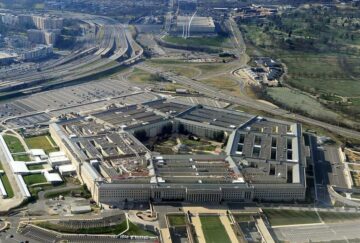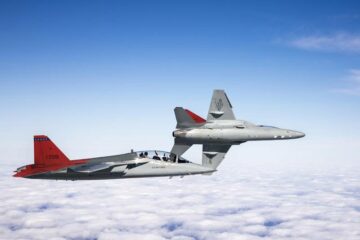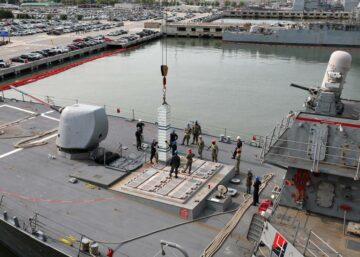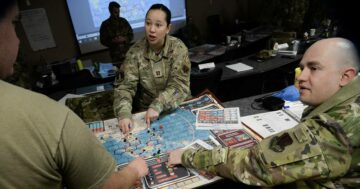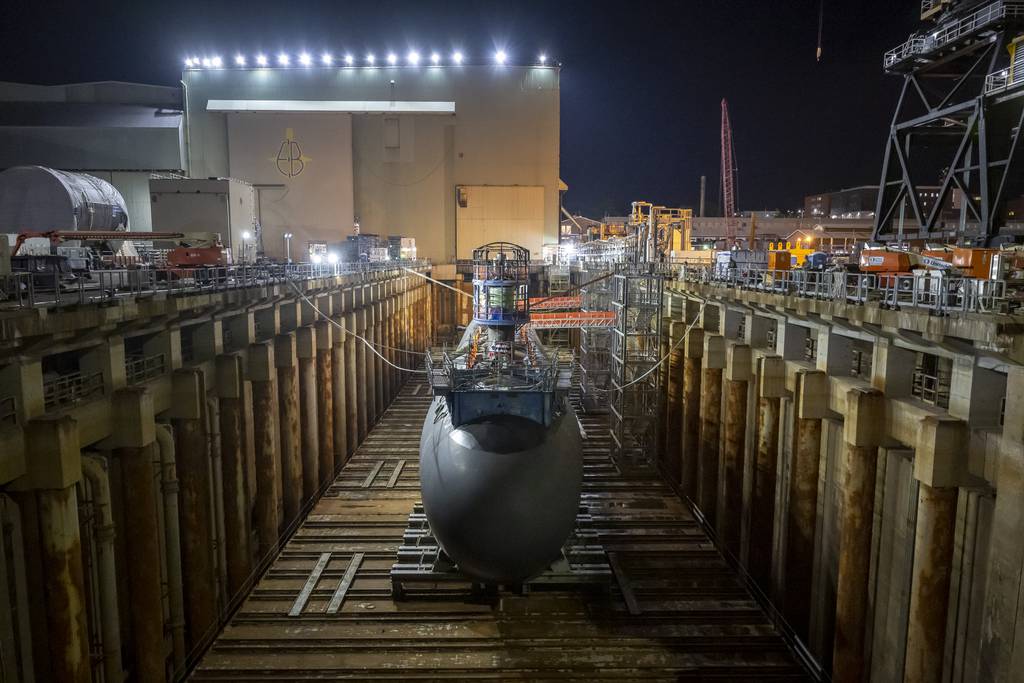
While many inside the beltway fixate on the current state of the submarine industrial base as a static picture, the Navy has made real progress in expanding capacity, service officials have assured Congress.
To put the challenge into perspective, currently, the lead shipyards, Electric Boat and Newport News Shipbuilding, are tasked with constructing about 100,000 tons worth of submarines. That is double the tonnage from just a few years ago. With more shipyards from Alabama, South Carolina, and Pennsylvania being onboarded in steel fabrication, the program will double again to 200,000 in the near future.
This upward trajectory should instill real confidence in our submarine industrial base.
It’s no secret, however, that the Navy has been challenged by operational availability rates of submarines because of continued backlogs, which undercuts our joint efforts to ramp up production.
While this may be true, the tide is clearly turning and should not be used as a reason to stall AUKUS.
It has been eight months since the heads of government of Australia, the UK, and the US announced the specific plan — the “optimal pathway” — to actualize the historic pact. It is an audacious package including the sale of three Virginia-class submarines to the Australian Navy and robust sharing and development of advanced technologies, and shipyard workforce.
To make it happen, several AUKUS measures proposed by the Navy have been chugging their way through various committees of the Senate and the House, with the goal of inclusion in the final Fiscal Year 2024 National Defense Authorization Act.
Thankfully, last week’s Senate passage of the Continuing Resolution was accompanied by a vote for the upper chamber to join the House in a Conference Committee on the legislation, which is loaded with pages of “must-do” provisions, arguably the most prominent being enabling language for execution of the AUKUS security agreement.
The sea services’s “strategic outsourcing” initiative was already funded by Congress as part of a $2.3 billion investment over the last few years. That will be augmented by an additional $3.7 billion in key sectors across the enterprise to ensure we have qualified workers, modernized shipyards, and a stable supply chain to meet this increased demand signal.
In congressional testimony in late October, Navy leaders asserted that these investments are already paying dividends. Thanks to new Navy partnerships with state and local talent pipelines across the country, there are over 7,000 workers entering the supplier base this year alone. This dramatic influx of workers, combined with targeted supplier development efforts, has increased capacity by 10 percent at 194 suppliers in 31 states.
By spreading construction work to smaller shipyards and expanding the use of advanced technology, the Navy has also significantly reduced construction pressure and improved efficiency.
Since May, the operational availability of attack submarines has increased from 60 to 66 percent and our committee made clear that the Navy has an aggressive, $2 billion strategy to hit 80 percent by 2028.
First, the Navy has already programmed investments to ensure spare parts are on shelves before repairs are even required — accelerating turnaround time. Second, like efforts made in submarine construction, the Navy is outsourcing both intermediate maintenance work and complete engineering overhauls from public to private shipyards to reduce pressure and add capacity at our public shipyards. Finally, President Biden’s $3.4 billion supplemental funding request cements the Navy’s ability to achieve an 80 percent operational availability rate.
Congress should feel confident in our submarine industrial base’s ability to meet the moment and prepare for increased demand over the next two decades. Now, lawmakers must put hesitations aside and act swiftly to fulfill the values President Biden reiterated to President Xi Jinping during their long-awaited meeting: a “connected, prosperous, secure, and resilient Indo-Pacific.”
Joe Courtney (D-Conn.) is the ranking member of the House Armed Services Seapower and Projection Forces subcommittee.
- SEO Powered Content & PR Distribution. Get Amplified Today.
- PlatoData.Network Vertical Generative Ai. Empower Yourself. Access Here.
- PlatoAiStream. Web3 Intelligence. Knowledge Amplified. Access Here.
- PlatoESG. Carbon, CleanTech, Energy, Environment, Solar, Waste Management. Access Here.
- PlatoHealth. Biotech and Clinical Trials Intelligence. Access Here.
- Source: https://www.defensenews.com/opinion/2023/11/21/us-submarine-production-rate-will-not-hinder-aukus/
- :has
- :is
- :not
- $3
- $UP
- 000
- 10
- 100
- 200
- 2024
- 2028
- 31
- 60
- 66
- 7
- 70
- 80
- a
- ability
- About
- accelerating
- accompanied
- Achieve
- across
- Act
- add
- Additional
- advanced
- Advanced Technology
- again
- aggressive
- ago
- Agreement
- Alabama
- alone
- already
- also
- an
- and
- announced
- ARE
- arguably
- armed
- AS
- aside
- assured
- At
- attack
- audacious
- augmented
- Australia
- Australian
- authorization
- availability
- base
- BE
- because
- been
- before
- being
- biden
- Billion
- boat
- both
- by
- Capacity
- Carolina
- chain
- challenge
- challenged
- Chamber
- clear
- combined
- committee
- complete
- Conference
- confidence
- confident
- Congress
- Congressional
- constructing
- construction
- continued
- continuing
- country
- Current
- Current state
- Currently
- decades
- Defense
- Demand
- Development
- dividends
- double
- dramatic
- during
- efficiency
- efforts
- eight
- Electric
- enabling
- Engineering
- ensure
- entering
- Enterprise
- Even
- execution
- expanding
- feel
- few
- final
- Finally
- Fiscal
- For
- Forces
- from
- Fulfill
- funded
- funding
- future
- goal
- Government
- happen
- Have
- heads
- hinder
- historic
- Hit
- House
- However
- HTTPS
- images
- improved
- in
- Including
- inclusion
- increased
- industrial
- influx
- Initiative
- inside
- instill
- Intermediate
- into
- investment
- Investments
- IT
- Jinping
- join
- joint
- jpg
- just
- Key
- language
- Last
- Late
- lawmakers
- lead
- leaders
- Legislation
- like
- local
- long-awaited
- made
- maintenance
- make
- many
- May..
- measures
- Meet
- meeting
- member
- moment
- months
- more
- most
- must
- National
- Near
- New
- news
- next
- no
- now
- october
- of
- officials
- on
- operational
- our
- Outsourcing
- over
- package
- pages
- part
- partnerships
- parts
- passage
- paying
- Pennsylvania
- percent
- perspective
- picture
- plan
- plato
- Plato Data Intelligence
- PlatoData
- Prepare
- president
- president biden
- pressure
- private
- Production
- Program
- programmed
- Progress
- Projection
- prominent
- proposed
- prosperous
- public
- put
- qualified
- Ramp
- Ranking
- Rate
- Rates
- real
- reason
- reduce
- Reduced
- repairs
- request
- required
- resilient
- Resolution
- robust
- sale
- SEA
- Second
- Secret
- Sectors
- secure
- security
- Senate
- service
- Services
- several
- sharing
- shelves
- should
- Signal
- significantly
- since
- smaller
- South
- South carolina
- specific
- Spreading
- stable
- State
- States
- static
- steel
- Strategy
- subcommittee
- supplier
- suppliers
- supply
- supply chain
- swiftly
- Talent
- targeted
- Technologies
- Technology
- testimony
- thanks
- that
- The
- the UK
- their
- There.
- These
- this
- this year
- Through
- Tide
- time
- to
- tons
- trajectory
- true
- two
- Uk
- upward
- us
- use
- used
- Values
- various
- Vote
- was
- Way..
- we
- which
- will
- with
- Work
- workers
- Workforce
- worth
- xi
- xi jinping
- year
- years
- zephyrnet

